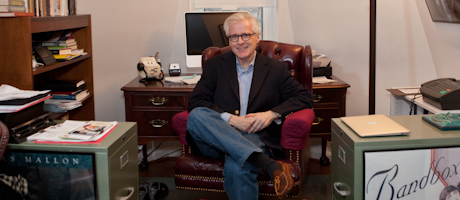By Julia Parmley
It isn’t often historical fiction writers meet their subjects.
But in 1968, on the Hempstead Turnpike in Long Island, a 16-year-old Thomas Mallon shook hands with then-presidential candidate Richard Nixon, whose involvement in the nation’s most infamous political scandal is the subject of Dr. Mallon’s latest book.
“Watergate,” to be released later this month by Pantheon, follows seven real figures during the Watergate era—including Fred LaRue, a Nixon presidential aide who was in charge of delivering payment to the burglars, and Alice Longworth, daughter of Theodore Roosevelt and longtime friend of Nixon— providing their perspectives as the scandal unfolds.
This book was four years in the making for Dr. Mallon, whose Foggy Bottom residence looks right at the Watergate complex, where five men broke into the Democratic National Committee headquarters on June 17, 1972.
“I think the subject, even 40 years later, still tantalizes and interests people,” said Dr. Mallon, a professor of English at GW. “Nixon has such a combination of the good and the bad, with both his accomplishments and his ‘dastardly deeds.’”
His eighth novel, “Watergate” has already received extensive recognition, including placement on Newsweek Magazine’s “12 for 2012” and O Magazine’s “17 Books to Watch for in February.”
Dr. Mallon said he was drawn to Nixon in part because the infamous president was “such an enormous figure” in his own life. Dr. Mallon was an undergraduate at Brown University when Nixon was president, and his own father was a “passionate supporter” of the man.
“Nixon was certainly one of the people who shaped the world that we live in, and he was a brilliant man who was so tangled up in his personality that he couldn’t help himself,” said Dr. Mallon. “There were times when his rational capacities— which were considerable — and his analytical capacities — which were great—were overruled by these dark impulses he had.”
One of the most interesting discoveries Dr. Mallon made while he researched was President Nixon’s ability to “disassociate” from Watergate while he was in the White House.
“During the months when his political fortunes were at his lowest and he was consumed by strategizing, [Nixon] was conducting foreign policy at a visionary level,” said Dr. Mallon. “The cliché of Nixon as this major foreign policy figure brought low by own compulsions and personality, I found not only true but truer than I thought.”
But in his book, Dr. Mallon said he wanted to focus on some of the cast that surrounded President Nixon during Watergate, and how the scandal “convulsed the whole city and whole class of political people.”
One of them was named E. Howard Hunt, an ex-CIA officer turned novelist who helped organize the first burglary. Dr. Mallon met Mr. Hunt in the early 1990s while Mr. Mallon was working as a literary editor for GQ. Mr. Hunt served almost three years in prison for his involvement in Watergate.
“Hunt was a man whose life was effectively destroyed by his getting involved in these dirty deeds,” said Mr. Mallon.
The complex itself, located on the Potomac River by Virginia Avenue, New Hampshire Avenue and F Street, also housed a number of the people involved in the scandal, a fact that surprised Dr. Mallon. Some of its residents included President Nixon’s secretary Rose Mary Woods and U.S. Attorney General John Mitchell, who served almost two years for conspiracy, obstruction of justice and perjury.
“The Watergate, which Nixon claimed never to have been in, figured more in the story than I thought,” said Dr. Mallon. “The book goes in and out of the complex a lot. There are scenes that take place inside apartments, and I hadn’t imagined that at first. I just thought of it as a place where the burglaries took place.”
As with many of his other novels, Dr. Mallon first began working on Watergate in the library. The sheer volume of material about the scandal was “enormous,” he said, and included transcripts of investigative hearings, data, memoirs and tapes. He said he almost had “too much to deal with.”
“What I’ve learned to do over the years is not to wait to start writing until you’ve done all research,” said Dr. Mallon, who serves as director of George Washington’s Creative Writing Program. “Get a basic command of the story and narrative arc you want to follow, then start writing and keep researching on a need-to-know basis; otherwise, you fall into a dissertation syndrome and you are never able to begin writing because there’s always more research to do.”
Although he didn’t move to D.C. until 2003, Dr. Mallon said he was always drawn to the District. Dr. Mallon’s past works include novels set at the U.S. Naval Observatory and Lafayette Square, both in Northwest, and he has already begun writing his next book, which is about the District in the 1980s. He loves living in Foggy Bottom, near the Watergate, the State Department and GW.
“[Foggy Bottom] has all those things to work on the imagination,” he said.
Imagination is part of the reason Dr. Mallon, who is currently serving a visiting position as McGee Professor of Writing at Davidson College in North Carolina, is drawn to historical fiction.
“The stories that are available are so dramatic and gaudy,” he said. “My own life is perfectly happy, but it’s calm and quiet and there’s not much to draw on there. Sometimes it’s better to write about what you don’t know and what you can research and learn. It’s comforting to write historical fiction and to know you’ll never run dry.”


